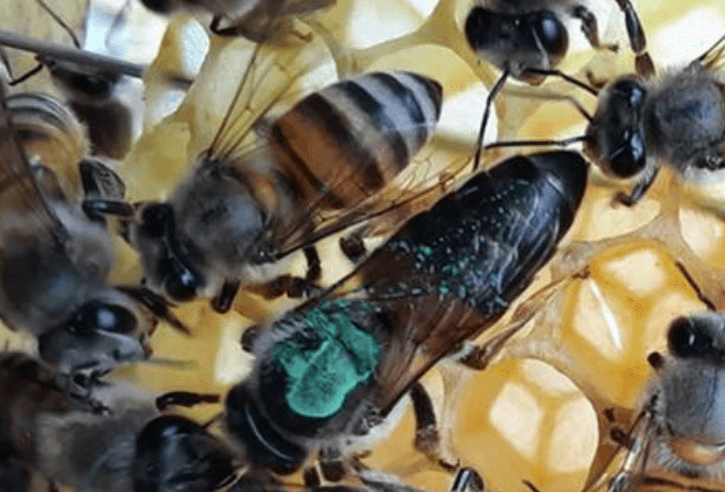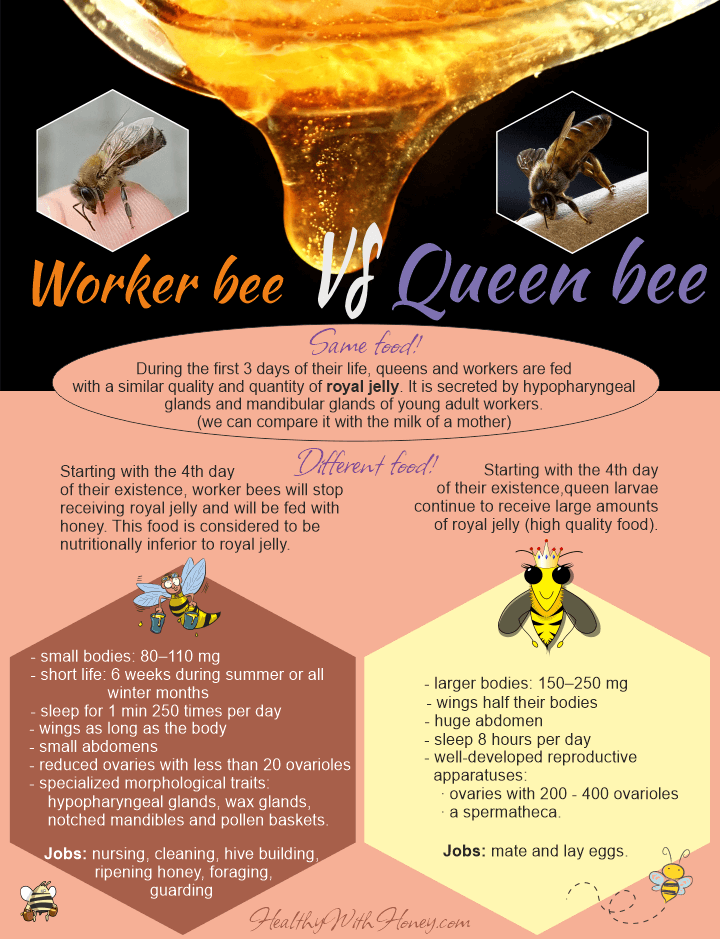While they start with the same background, queens and worker bees turn out to be different. They all eat royal jelly in the first 3 days, but after that, only the bees that will continue to receive royal jelly will become queens. The rest will be fed honey and become workers.
We all know that queen honey bees are the ones that lay the eggs for future bees. Due to their preferential treatment, receiving only royal jelly as food, queens develop a reproductive apparatus of ovaries with 200 to 400 ovarioles and a spermateca.
From their 5th day of existence, queens can be fecundated by drones (bee males). They can be up to 40, but usually around 8 or 12. After the fecundation, the drones die.
The queen rests for a few days, and then she will start laying eggs for the rest of her life.
It will be very productive for the first 2 years. A queen can live up to 5 years, and there have been reports of queens living even for 8 years.
Do worker bees lay eggs?
Yes, they can, and they do. Even if their reproductive system is not as developed as it is in queens, they still have the ability to reproduce. But since the fecundation doesn’t exist, their eggs will be haploid and will develop into males. Scientists call this “arrhenotokous parthenogenesis” meaning that unfertilized eggs develop into males.
Curious right? How unfecundated eggs became males!
There are exceptions to this rule: the workers of the species Cape honey bee (Apis mellifera capensis) are able to lay diploid, female eggs by “thelytokous parthenogenesis” (all eggs are unfertilized and give rise to females).
Workers do not usually produce eggs when the queen is present in the colony. However, they can and sometimes do it. But the other worker bees are able to differentiate the eggs laid by workers from the ones laid by the queen, and quickly and selectively remove them from the colony. The drones the queens lay are enough!
read more on The jobs of a bee. What is the life of a bee?
What happens when the queen of a hive dies?
If the queen of a hive is lost and cannot be replaced, worker bees will lay as many eggs as they can. Unfortunately, their eggs will become drones (males) and drones can only fecundate the queen, nothing else. The colony will eventually break down due to lack of young workers.
What is the difference between queen bee and worker bee?
| Worker honey bee | Queen honey bee |
|---|---|
| – small body (80 – 110mg) – wings as long as the body – small abdomen – much shorter vagina – the valve fold is lacking – reduced ovaries with less than 20 ovarioles – specialized morphological traits: hypopharyngeal glands, wax glands, notched mandibles and pollen baskets.- can lay 5 to 38 eggs for individual laying workers. |
– larger body (150–250 mg) – wings reach half their bodies – huge abdomen – rudimentary spermatheca that serves to store semen – valve fold, thought to press ovulated eggs against the opening of the spermathecal duct – ovaries with 200–400 ovarian filaments (ovarioles) – spermatheca, which makes her able to perform one of her most important social tasks, laying eggs. -During peak egg-laying periods, a queen may produce 1500 or more eggs/day. |

*******************
References and further readings:
Differences between queen- and worker-laid male eggs of the honey bee (Apis mellifera)




